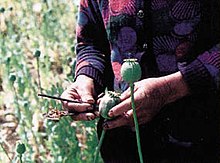
Back أفيوني Arabic Опиати Bulgarian আফিমজাত ঔষধ Bengali/Bangla Opijat BS Opiaci Catalan Opiát Czech Opiat Danish Opiat German Οπιούχα Greek Opiáceo Spanish


An opiate is an alkaloid substance derived from opium (or poppy straw).[1] It differs from the similar term opioid in that the latter is used to designate all substances, both natural and synthetic, that bind to opioid receptors in the brain (including antagonists).[2] Opiates are alkaloid compounds naturally found in the opium poppy plant Papaver somniferum.[3] The psychoactive compounds found in the opium plant include morphine, codeine, and thebaine (figure below is wrong, thebaine is "3,6-Dimethoxy-"). Opiates have long been used for a variety of medical conditions, with evidence of opiate trade and use for pain relief as early as the eighth century AD.[4] Most opiates are considered drugs with moderate to high abuse potential and are listed on various "Substance-Control Schedules" under the Uniform Controlled Substances Act of the United States of America.
In 2014, between 13 and 20 million people used opioids recreationally (0.3% to 0.4% of the global population between the ages of 15 and 65).[5] According to the CDC, from this population, there were 47,000 deaths, with a total of 500,000 deaths from 2000 to 2014.[6] In 2016, the World Health Organization reported that 27 million people suffer from opioid use disorder. They also reported that in 2015, 450,000 people died as a result of drug use, with between a third and a half of that number being attributed to opioids.[7]
- ^ "Definition of OPIOID". www.merriam-webster.com. 2023-11-06. Retrieved 2023-11-11.
- ^ Hemmings, Hugh C.; Egan, Talmage D. (2014). Pharmacology and Physiology for Anesthesia: Foundations and Clinical Application: Expert Consult - Online and Print. Elsevier Health Sciences. p. 253. ISBN 978-1437716795.
Opiate is the older term classically used in pharmacology to mean a drug derived from opium. It has been used in the past to refer to drugs with opium-like effects, but that use is dated. Opioid, a more modern term, is used to designate all substances, both natural and synthetic, that bind to opioid receptors (including antagonists).
- ^ "Opiate - Definitions from Dictionary.com". dictionary.reference.com. Retrieved 2008-07-04.
- ^ Brownstein, M J (1993-06-15). "A brief history of opiates, opioid peptides, and opioid receptors". Proceedings of the National Academy of Sciences of the United States of America. 90 (12): 5391–5393. Bibcode:1993PNAS...90.5391B. doi:10.1073/pnas.90.12.5391. ISSN 0027-8424. PMC 46725. PMID 8390660.
- ^ "Status and Trend Analysis of Illict [sic] Drug Markets" (PDF). World Drug Report 2015. Retrieved 26 June 2015.
- ^ "CDC Press Releases". CDC. 2016-01-01. Retrieved 2019-10-17.
- ^ "WHO | Information sheet on opioid overdose". WHO. Retrieved 2019-10-21.